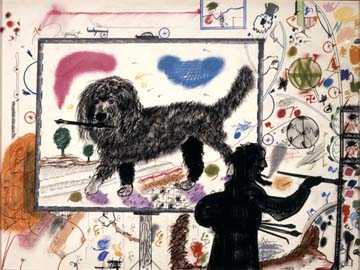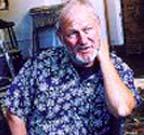
Roy De Forest
American, 1930-2007
Untitled RDF-78-5H, n.d.
pastel on paper
22 1/4 x 29 3/4 in.
SBMA, Museum purchase with Schaffner Fund
1979.3

Roy De Forest photographed in his studio in Port Costa, CA, in 2002
COMMENTS
Roy De Forest at George Adams
Art in America, April, 2006 by Stephen Maine
Within a few years of joining Robert Arneson, William T. Wiley, Wayne Thiebaud and others at UC Davis in the mid-1960s, Roy DeForest developed his signature contribution to that amazingly fertile milieu. To his pictures of wild-eyed hounds, horses, birds and humans wandering a dense, primitive dreamscape that may be Northern California, he brought the accessibility and demystification of the art-making process that is central to Pop. But he stuck with another sort of mystification: the cult of the artist's personality. In DeForest's version of Bay Area eccentricity, delight in color, surface and pattern is as palpable as Matisse's, and time has not mellowed the willful ham-handedness of his painterly attack.
DeForest's first solo show since 1997 included eight paintings in acrylic on canvas, all about 5 feet to a side and completed in 2005. Several feature a central personage attended by ancillary sidekicks, co-conspirators and alter egos. A Country Life evokes the tradition of the commemorative portrait; a robust blond farmer or cowboy, in his Sunday best, is surrounded by medallion-like portraits of horses, cattle, poultry, perhaps family members and numerous garrulous hounds. They are shown against a backdrop of loose grids suggesting cultivated fields or gardens. Present Company presents its cast of big-nosed folks, dogs and birds in four distinct strata. Spiked dots applied directly from a tube of paint cover the faces of many characters, connoting not a skin condition but a more general malaise. Elsewhere, blunt squirts of paint vie with passages of surprising delicacy, as in the sly, nasty bunnies in Song of the Blackbird.
Roy De Forest, 77, Painter Of Colorful, Comic Scenes
By ROBERTA SMITH
Published: New York Times, May 23, 2007
Roy De Forest, a Bay Area artist whose paintings depicted a comical, crowded frontier land of people and animals in patchworks of scorched, textured color, died on Friday in Vallejo, Calif. He was 77 and lived in nearby Port Costa.
His death was confirmed by George Adams, his New York dealer, who said the cause had not been determined.
Mr. De Forest belonged to a group of Bay Area individualists who included Robert Arneson, Joan Brown, William T. Wiley and Peter Saul. They were often grouped under the heading of Funk, a term Mr. De Forest disliked; the New York art world tended to lump them together as regionalists.
Most were versed in Abstract Expressionism but gradually turned its formal lessons to narrative, nonabstract ends. Mr. De Forest's abstractions morphed into crusty maplike expanses teeming with odd textures, cartoon details, little folk-art silhouettes and swarming dots.
He was a lover of dogs, rarely owning fewer than two. By the mid-1960s he had developed a sardonic Americana of guys and dogs, overlapping with other animals, birds and sometimes imaginary beings in flattened landscapes, whose hallucinatory colors and a down-home woodsiness presaged the nascent counterculture. The dots developed into coarse pointillism, becoming something of a trademark; the little dollops of paint resembled chocolate chips (or for some, LSD tabs).
The son of migrant farm workers, Mr. De Forest was born in North Platte, Neb., in 1930 and grew up mostly in Yakima, Wash., where he attended junior college. He studied on a scholarship at the San Francisco Art Institute, where his teachers included the prominent local artists Hassel Smith, Elmer Bischoff and David Park, and later earned bachelor's and master's degrees from San Francisco State College. He taught at the University of California, Davis, from 1965 to 1992.
He is survived by his wife, Gloria; a daughter, Oriana, and a son, Pascal, both of Concord, Calif.; and three sisters, also of California: Beth Jacobs of San Leandro, Beverly Lagiss of Livermore and Lynn Robie of Sacramento.
His first solo show was at the East & West Gallery in San Francisco in 1955. Starting in 1966, he exhibited regularly at the Allan Frumkin Gallery in New York. A retrospective organized by San Francisco Museum of Modern Art came to the Whitney Museum of American Art in 1975.
In that show's catalog, Mr. De Forest identified himself as an ''obscure visual constructor of mechanical delights'' and quoted a talking dog, named Samuel Johnson, who said, ''What is current taste but old desires made palatable by present boredom.''
IN MEMORIAM
Roy De Forest
Professor of Art, Emeritus
UC Davis
1930 – 2007
Roy De Forest, one of the most prolific and imaginative artists of his generation, died unexpectedly at Kaiser Permanente, Vallejo Medical Center on May 18, 2007 after a brief illness. He was 77. He is survived by his wife of 34 years, Gloria, two children: son, Pascal, and daughter, Oriana, both of Concord; and three sisters: Beth Jacobs of San Leandro, Beverly Lagiss of Livermore and Lynn Robie of Sacramento.
De Forest had his home and studio in the small town of Port Costa, California. That location offered him a unique confluence of advantages: he was personally surrounded by the rural fields, cattle, birds, and dogs that so populated his imagery mind, while still located at the center of the vibrant San Francisco Bay area art community.
Born in North Platte, Nebraska to a farm worker family during the Great Depression, De Forest grew up in Nebraska, Colorado, and eastern Washington State - where he took his associate degree in math and humanities from Yakima Junior College in 1950. He then spent a number of years studying art before attending the California School of Fine Arts in San Francisco (now know as the San Francisco Art Institute.) He ended his formal education by taking his bachelor’s and, after service in the Army, his master’s degrees from San Francisco State University.
By the time De Forest joined the nascent UC Davis Art Department as a Lecturer in 1965, he had already well begun his national reputation as a painter (he became an assistant professor in 1967, rose to full professor in 1974, and retired in 1992). Roy was one of the “founding fathers” of an Art Department that was to quickly realize a national and international reputation for the singular qualities of its faculty, the cumulative breath of their artistic concerns, and the unique Master of Fine Arts degree program that was the Art faculty’s equally shared obligation and responsibility.
De Forest’s remarkable artistic production of paintings, drawings, prints, sculptures, and folk objects continued uninterrupted throughout his long career. His artworks are to be found in many, many private art collections (to the continuing pure delight of their owners), and some of the most well respected public art collections, such as the San Francisco Museum of Modern Art, the Fine Arts Museums of San Francisco, the Crocker Art Museum of Sacramento, the Hirshhorn Museum of Washington, D.C., the Smithsonian American Art Museum, Washington, D.C, and many others. A “Roy De Forest Retrospective Exhibition” originated in 1974 at the San Francisco Museum of Modern Art and traveled to the Whitney Museum of American Art in New York City the following year. His complete list of public exhibitions is in the hundreds and his continuous and unabated prolific artistic production can serve as a model for any fully engaged young artist.
To know and understand Roy’s artwork is to know and understand Roy. He was human imagination incarnate. His artworks are populated with a menagerie of creatures – some identifiably of this world, others inhabitants of some purely imaginary land, all living narrative lives in some unbounded territory between reality and magic. In addition to the wonder and joy of his imagery, Roy was known as an artist’s artist. He constantly found new ways to apply paint/pigment/mark to paper/canvas/wood. To view one of his paintings or drawings is to enlarge one’s understanding of the fundamental act of artistic mark-making. A line traced along a French curve becomes a canoe; a series of squiggly black crayon marks on a yellow field above a silhouette of a face becomes a 1920’s flapper hairdo in a lithograph. Roy took great delight in artmaking – in the power of images and in the nature of artistic creation. That delight and totally artistic engagement is present in his work as whimsy bonded to meaning created in joy.
In his last New York exhibition, at the George Adams Gallery in 2005, the New York Times art critic, Roberta Smith said: “At 75, Mr. De Forest is painting pretty much what he has painted for years: dogs, men in hats or headdresses, and supernatural beings against a flattened terrain. Angular, masklike, brusquely rendered, they all seem shamanistic and slightly crazed; their bright, staring eyes imply the ingestion of hallucinatory substances.” And “His new works have become slightly more structured: compartmentalized into patchworks of portraits, friezes and pictures within pictures, as if the artist had a new appreciation for classic American folk art. They are also more inventive and sensuous in their handling of paint. The bristling textures have diversified -- new additions include mosaiclike sections of dried acrylic paint -- and the clearer composition increases their impact. These works have a blatant, consummate ease. If Mr. De Forest's goal is to transfer the ecstatic experience of the world from his creature-subjects to his creature-viewers, it has never been more clearly or radiantly stated.”
To personally encounter Roy was - not unlike viewing his artwork - a unique experience - always surprising, always amazing. He had a gentle demeanor coupled to an incisive intelligence; a great generosity of spirit matched by an amazing capacity for spontaneity, and a warm open smile that hinted at untold imaginative secrets. He was a wonderful artist, a giving teacher, a truly genuine colleague, and an American original.
Mike Henderson
Harvey Himelfarb
Gina Werfel
As in some pre-Renaissance painting, the relative sizes of the players might imply narrative hierarchy, but among the most pungent portraits are the smallest, like the demented, apple-red pup who reigns mascotlike at the top center of The Saga of the Shepard Brothers. Almost everyone appears a little uneasy in these paintings, uptight but zoned-out. The lounging avians in The Birdwatcher are oblivious to the blank-eyed, daydreaming humans below, whose reveries seem to include an anxious hound and a bristling baboon. All four fellows have funny hats and noses; one has infiltrated the birds' treetop domain with the aid of a beak disguise. The painting suggests a symbolic approach to color, with earthy colors at bottom giving way to a bejeweled, heavily ornamented sky in tropical hues.
Reminders of DeForest's contribution to the rich tradition of California assemblage, his paintings' custom-built frames feature yet more funk, like the heads attached to North of Patagonia, some of which might be the thought bubbles of others. Among these somnambulant, sightless (or all-seeing) zombies is the show's most motivated character, a red-nosed hooligan with a brush cut and his "game face" on. Scabrous paint, like mishandled grout in candy colors, yields, in this atypically sweeping canvas, to a radiant, palm-flecked hillside.
